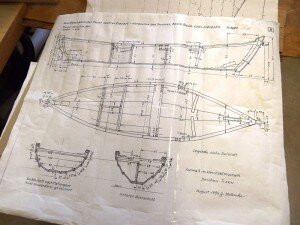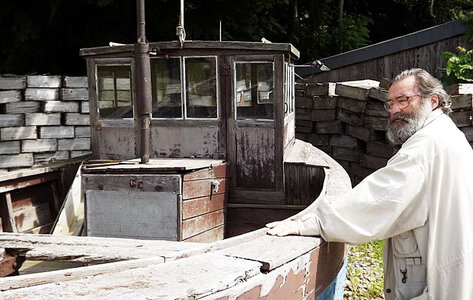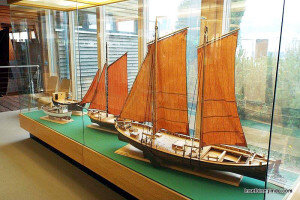
The Story in Here is a about two books and the life's work of one man: Helmut Olszak. He was a simple craftsman of no academic background rescuing a great and rich treasury of German history to us. He was the man who invested his last 20 years lifetime into the research of the traditional skiffs of the southern Baltic Seas - being able to publish two books together with Manfred Sohn:
"Von Polten und Quatzen" – Pommersche Fischerei- und Händlerfahrzeuge, Eigenverlag 2016, Co-Autor - ISBN 978-3-00-052098-3
And his biggest plan collection in "wooden fishing boats of the southern Baltic Seas coast"
"Hölzerne Fischereiboote der südlichen Ostseeküste", Eigenverlag Michael Sohn 2014, ISBN 978-3-00-044904-8
With 267 drawings of skiffs, boats, barges and even an iceboat...
So he was the man being phoned in his small flat in Berlin when a wreck was found. So he came measuring the reliefs of the boats and barges in his rubber boots and identifying them as being built in Eastern and Western Prussia or Pommerania.

He - as Howard I.Chapelle - measured a wreck, made a fought sketch and than the drawing of the wreck's status as noted in 1/15; and started the reconstruction in the drawing board in a slip of frostpapier over it. After this the typically three Swedish foot long model was built in 1/15 in oak and pine and checked by light. If it doesn't fit and light does come out between the planks Helmut pushed it in the oben and started a with new pice of frostpapier on the wreck situation and restarted the process in his flat again and again 'till it does fit. "If it doesn't work with the original material and the planks does lay smoothly in their formers I must bei wrong with my reconstruction - the original boat IS allways right. So what was added by me was wrong!"
He got the oak bars from construction workers, stored old doors and cabinets in parts in his flat and was happy standing with the old heated iron in his shipyards bending 4mm oak planks to shape. So he was able to document the most signifikant ships of the southern Baltic Seas coast. As they were builded in traditional ways by the rule of the thumb and measured in not in the Prussian - but in Swedish foot untill His work no real technical drawings we're available without Werner Jägers book about on "Haffkähne" (Prussians Haff semi sea barges) of Eastern Prussia. As the boatbuilders we're heavyly influenced by Swedish origins and masters.

His collection is now in the "Nautineum" at Stralsund - filling a hole division of it's own right in the building. Helmut is one of the man rescuing the belongings of German traditional skiffbuilding from being forgotten. He was long time disabled by illness and still had had his drawing board in the small room in the hospital he lived in, he sadly passend away in 2017. Thanks to him.
Last edited:



